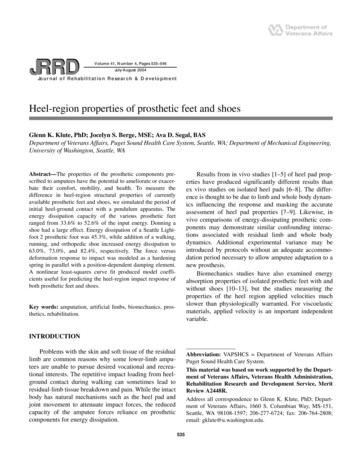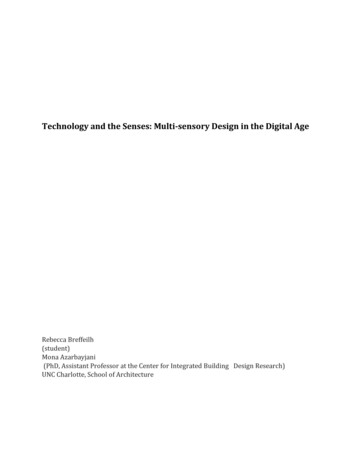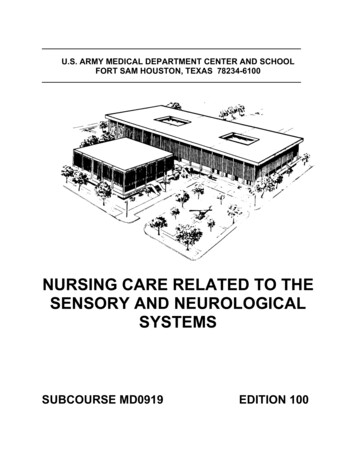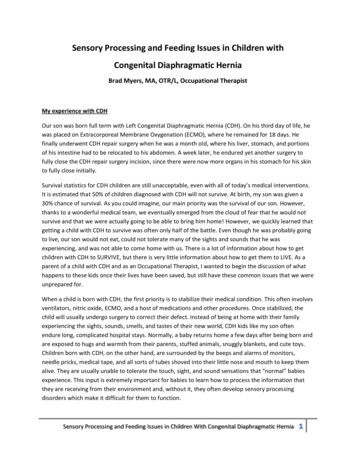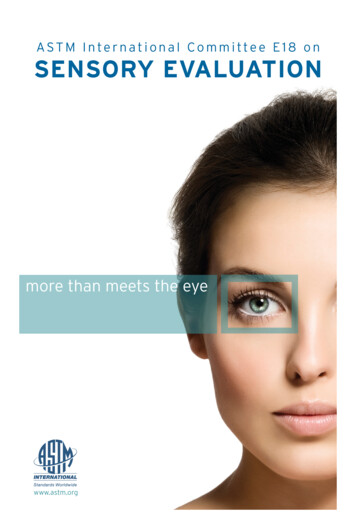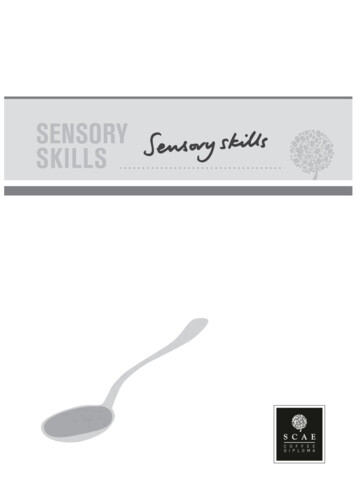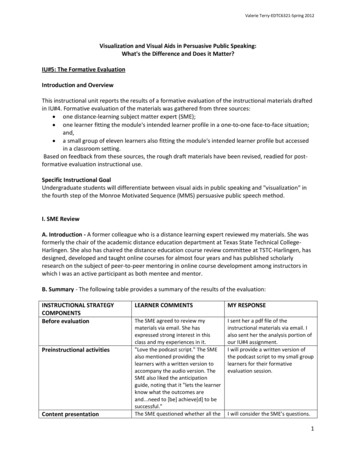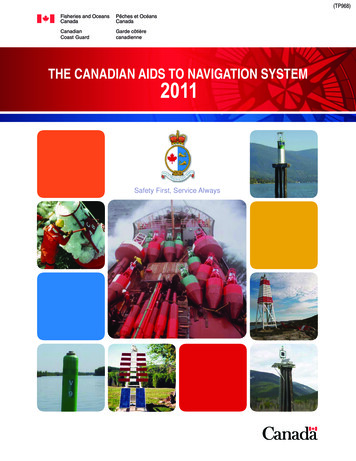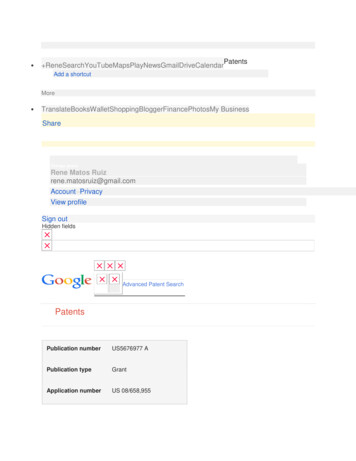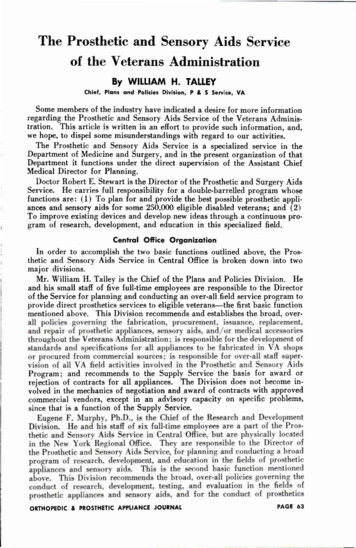
Transcription
The Prosthetic and Sensory Aids Serviceof the Veterans AdministrationBy W I L L I A MH. TALLEYChief, Plans and Policies Division, P & S Service, VASome members of the industry have indicated a desire for more informationregarding the Prosthetic and Sensory Aids Service of the Veterans Adminis tration. This article is written in an effort to provide such information, and,we hope, to dispel some misunderstandings with regard to our activities.The Prosthetic and Sensory Aids Service is a specialized service in theDepartment of Medicine and Surgery, and in the present organization of thatDepartment it functions under the direct supervision of the Assistant ChiefMedical Director for Planning.Doctor Robert E. Stewart is the Director of the Prosthetic and Surgery AidsService. He carries full responsibility for a double-barrelled program whosefunctions are: ( 1 ) T o plan for and provide the best possible prosthetic appli ances and sensory aids for some 250,000 eligible disabled veterans; and ( 2 )To improve existing devices and develop new ideas through a continuous pro gram of research, development, and education in this specialized field.Central Office OrganizationIn order to accomplish the two basic functions outlined above, the Pros thetic and Sensory Aids Service in Central Office is broken down into twomajor divisions.Mr. William H. Talley is the Chief of the Plans and Policies Division. Heand his small staff of five full-time employees are responsible to the Directorof the Service for planning and conducting an over-all field service program toprovide direct prosthetics services to eligible veterans—the first basic functionmentioned above. This Division recommends and establishes the broad, over all policies governing the fabrication, procurement, issuance, replacement,and repair of prosthetic appliances, sensory aids, a n d / o r medical accessoriesthroughout the Veterans Administration; is responsible for the development ofstandards and specifications for all appliances to be fabricated in VA shopsor procured from commercial sources: is responsible for over-all staff super vision of all VA field activities involved in the Prosthetic and Sensory AidsProgram; and recommends to the Supply Service the basis for award orrejection of contracts for all appliances. The Division does not become in volved in the mechanics of negotiation and award of contracts with approvedcommercial vendors, except in an advisory capacity on specific problems,since that is a function of the Supply Service.Eugene F. Murphy, Ph.D., is the Chief of the Research and DevelopmentDivision. He and his staff of six full-time employees are a part of the Pros thetic and Sensory Aids Service in Central Office, but are physically locatedin the New York Regional Office. They are responsible to the Director ofthe Prosthetic and Sensory Aids Service, for planning and conducting a broadprogram of research, development, and education in the fields of prostheticappliances and sensory aids. This is the second basic function mentionedabove. This Division recommends the broad, over-all policies governing theconduct of research, development, testing, and evaluation in the fields ofprosthetic appliances and sensory aids, and for the conduct of prosthetics
educational projects, conferences, or courses within the Veterans Administra tion. It is responsible for over-all supervision and coordination of theseactivities as conducted by contractors a n d / o r the V A Prosthetics Center. Itis also responsible for reviewing and recommending for approval all proposalsfor research or development presented to the Service, and for review andapproval of all vouchers submitted by research contractors.Field Service ProgramT o carry the Prosthetic and Sensory Aids Program directly to the disabledveterans for whom it exists, some 680 full-time and part-time employees aredirectly involved in providing direct prosthetics services to veterans throughregional offices and hospitals throughout the United States, Alaska, Hawaii,and Puerto Rico.The majority of our full-time employees (approximately 190) are locatedin Prosthetic and Sensory Aids Units or Sections in regional offices and incertain hospitals having outpatient medical activities. The Chiefs of theseunits, who are all amputees or otherwise seriously disabled, are generallyreferred to as Prosthetic Representatives, and are primarily responsible for theprosthetic and sensory aids program within their areas. They are the oneswho have most direct contact with individual members of the orthopedicand prosthetic appliance industry.The next largest group of full-time field employees (approximately 160)are assigned to the 28 V A Orthopedic Shops in operation throughout theUnited States and Puerto Rico. These shops are all located in VA hospitalswith medium to large orthopedic patient loads, and are intended primarilyto provide orthopedic braces and supports, and repairs thereto, for hospitalpatients. It is an established policy that these VA shops are to be utilized byfield stations only in those instances where local commercial sources are notavailable or are unable to meet the demands of the stations concerned, wherethe quality of appliances furnished by commercial vendors is not satisfactoryto prescribing physicians, a n d / o r where the prices charged by local vendorsare excessive. It is the prerogative of local field station Managers to deter mine whether these conditions exist.Prosthetic Clerks are assigned in each of the 176 V A hospitals in operation,but many of these employees spend only part of their time on prostheticsactivities because of the small numbers of appliances required in the majorityof hospitals. These clerks normally have direct contact with local membersof the industry, and handle all necessary administrative paper work involvedin furnishing appliances.New York Prosthetics CenterThe newly organized V A Prosthetics Center in New York City, headed byMr. Anthony Staros, has a total of 68 employees. The Limb and Brace Sec tion of that Center (formerly the Orthopedic Shop) has now been reducedto 35 employees. As the industry is aware, this is the only VA shop whereartificial limbs are fabricated (except for the shop in Puerto Rico, which isa special situation). The primary functions of the Limb and Brace Sectionunder the V A Prosthetics Center, as now established, are:( 1 ) T o fabricate and repair experimental artificial limbs a n d / o r otherappliances required in shakedown or service testing under the V A ProstheticsResearch and Development Program;(2) To fabricate and repair artificial limbs a n d / o r other appliances forproblem cases referred to the shop by the New York Regional Office or byother V A field stations throughout the United States and Puerto R i c o ;
WILLIAM H . TALLEYA disabled veteran of W o r l d W a rII, William H. (Bill) Talley has beenin the VA Prosthetic and SensoryAids Program since his retirementfrom the Army in October, 1 9 4 6 ,when he was assigned to the Rich mond, Virginia, Branch Office. InJuly of 1947, he was transferred toWashington, and in December of1953 assumed his present duties asChief, Plans and Policies Division,Prosthetic and Sensory Aids Service.Mr. Talley was born in Maiden,Missouri, in 1917, but spent most ofhis life in Paducah, Kentucky, whichis still considered "home". Prior tohis entry into military service, Mr.Talley was a Construction Estimatorand Salesman f o r a building con struction company in Paducah. Hevolunteered f o r military service inthe Army as a Private, was sent tothe European Theater as a Captainassigned to the 3rd Armored Divi sion, and was retired for disability asa Lieutenant Colonel after losingboth legs below the knees in com bat during the ill-famous "Battle ofthe Bulge."( 3 ) T o conduct pilot studies, as requested, on the use of materials orfabrication techniques for use in developing standards or specifications,to determine whether prices charged by the industry for specific appliancesor repair operations are within reason:( 4 ) T o fabricate and repair artificial limbs a n d / o r other appliances forveterans residing within the New York metropolitan area who refuse to utilizelocal commercial sources of supply:( 5 ) T o constantly train technicians in the latest approved techniques oflimb and brace fabrication so as to provide a nucleus for immediate, tempo rary expansion of the Veterans Administration shop program in the event ofwar or national disaster.Other Special Field ActivitiesA total of 13 Plastic Eye and Restorations Clinics, employing a total of 37technicians, are operated by the Veterans Administration in selected fieldstations throughout the United States. These clinics fabricate plastic artificialeyes, eve implants, plastic cosmetic restorations of all kinds i including partialcosmetic hands, but not including complete cosmetic hands except in unusualcases), metal or plastic skull plates, plastic ear inserts for fitting of hearingaids, and other special plastic appliances.Orthopedic or general surgeons are employed on a Consultant basis to headeach of the 30 Orthopedic and Prosthetic Appliance Clinic Teams locatedin selected field stations throughout the United States. As the industry wellknows through its valued participation in these Clinic Teams, they were estab lished for the primary purpose of providing proper appliances for problemcases where previous difficulty has been encountered, and to assist in fieldevaluation projects conducted under the Prosthetics Research and Develop ment Program.
The reorganized Prosthetic Distribution Center, located at the Denver Fed eral Center, Denver, Colorado, and headed by Mr. Clarence O. Cherry, willemploy approximately 15 people. The two Prosthetic Distribution Centerspreviously operating were consolidated at the one Center in Denver effectiveJune 1, 1956. This one Center will handle the procurment and distributionof stump socks and hearing aid batteries for all disabled veterans throughoutthe United States and its territories or possessions, as well as for eligibleveterans residing or traveling in foreign countries.Last, but certainly not least among the field employees in the Prostheticand Sensory Aids Programs, are the seven Area Chiefs, Prosthetic and SensoryAids Service, employed in the seven Area Medical Offices supervising all V Afield activities. These Area Chiefs, who are all amputees, are directly respon sible for prosthetics field activities within their respective areas, and reportthrough their Area Medical Directors to the Prosthetic and Sensory AidsService in Central Office. One of their primary responsibilities is to maintaingood relations between the V A field stations and members of the orthopedicand prosthetic appliance industry located within their areas. They are respon sible for inspecting artificial limb and brace shops in their areas, and theirreports have great influence upon the rating of such shops in Central Office.They supervise the work of all Prosthetic Representatives within their areas,and have administrative control over the activities of Orthopedic Shop Super visors and Chiefs of Plastic Eye and Restorations Clinics. These men arethe "eyes and ears" of the Prosthetic and Sensory Aids Service, and areamong our most important employees.Prosthetics Research, Development, and Education ProgramThe Prosthetics Research, Development, and Education Program is con ducted primarily through selected universities, and other non-profit organiza tions under contract to the Veterans Administration. For that reason, thereis only one specific V A field activity, the Testing and Development Laboratoryof the V A Prosthetics Center, primarily involved in the program. All the fieldactivities outlined above, however, are involved to some extent in the program,primarily in the testing a n d / o r field evaluation phases.The Prosthetics Research Board of the National Research Council operatesunder contract to the Veterans Administration, and is primarily responsiblefor coordinating the work of V A contractors and the laboratories of the Army,Navy, and Veterans Administration engaged in research and development ofartificial limbs. The Board also serves as an advisory body to the VeteransAdministration on all matters pertaining to research, development, and educa tion in the field of artificial limbs, and recommends the acceptance or rejec tion of all experimental limbs, terminal devices, or components developedand/or evaluated under the prosthetics research program.The Prosthetic Education phase of the program is the primary responsibilityof Mr. William M. Bernstock, under the direct supervision of Doctor Murphyin New York. Prosthetics education is considered to be an integral part ofthe over-all Prosthetics Research and Development Program, since it is oflittle value to develop improved devices or new techniques unless people canbe trained in their fabrication or use. For that reason, much effort andmoney has been expended under this program, not only for training of ourown Veterans Administration personnel, but also for training of members ofthe industry, private physicians and therapists, and employees in other Gov ernment agencies. Although members of the industry have been required
to pay small tuition charges for attendance at certain courses conducted atNew York University and the University of California, these fees cover onlya very small percentage of the total cost of establishing and operating suchcourses. The major portion of the costs, in all such courses, has been paid forby the Veterans Administration. Such education and training will be con tinued as long as the need exists and money is available.StatisticsIn order for the industry to have a better understanding of the scope ofthe over-all Prosthetic and Sensory Aids Program, a few statistics might behelpful.The total over-all cost of the Prosthetic and Sensory Aids Program, includ ing research and educ
Central Office Organization In order to accomplish the two basic functions outlined above, the Pros thetic and Sensory Aids Service in Central Office is broken down into two major divisions. Mr. William H. Talley is the Chief of the Plans and Policies Division. He and his small staff of five full-time employees are responsible to the Director of the Service for planning and conducting an .
